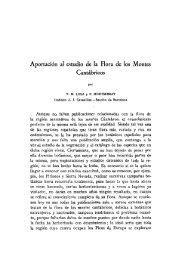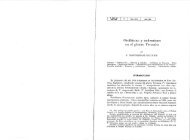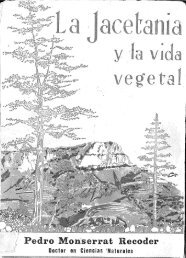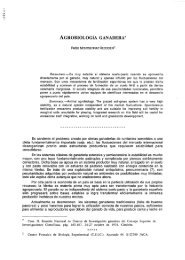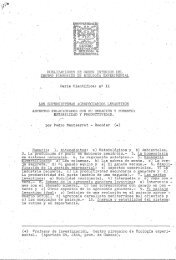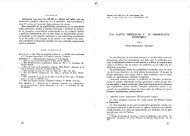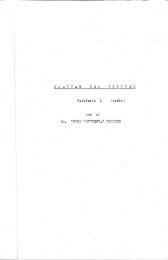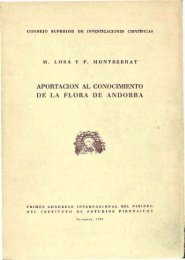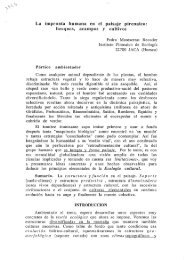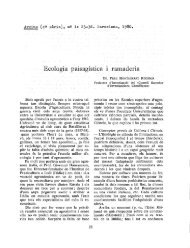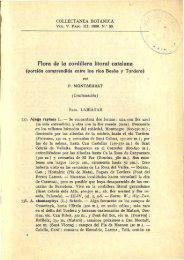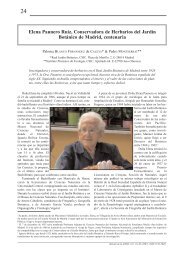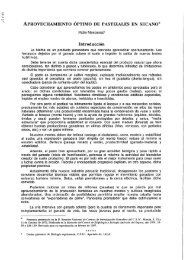the systems of grassland management in spain - Publicaciones del ...
the systems of grassland management in spain - Publicaciones del ...
the systems of grassland management in spain - Publicaciones del ...
Create successful ePaper yourself
Turn your PDF publications into a flip-book with our unique Google optimized e-Paper software.
48Information on <strong>the</strong> distribution <strong>of</strong> traditionalherds <strong>in</strong> Spa<strong>in</strong> can be found <strong>in</strong> general books, for<strong>in</strong>stance, Sarazá et al. (1975) 01' <strong>in</strong> regionalmonographs: Rodríguez (1955); Echevarria Belzunegui(1975); Francia (1978); de Miguel (1978);Sánchez (1978).THE MAIN GRAZING SYSTEMS IN SPAIN AT THEPRESENT TIMEInlroduelionThe maps <strong>in</strong> Fig.3.7 summarize <strong>the</strong> uses <strong>of</strong>agricultural and forested land. They are based on<strong>the</strong> most recent statistics supplied by <strong>the</strong> M<strong>in</strong>isteriode Agricultura (1980). Our ma<strong>in</strong> aim has been toshow, quantitatively, <strong>the</strong> relationship <strong>of</strong> differentprov<strong>in</strong>ces to ane ano<strong>the</strong>r.The relative importance <strong>of</strong> different types <strong>of</strong>land usage is summarized <strong>in</strong> <strong>the</strong> central diagram,that is, agricultural, forested, meadow and pasturelandand o<strong>the</strong>r miscellaneous uses. More than 70%<strong>of</strong> <strong>the</strong> land is taken up by cultivation and forestry.The great pla<strong>in</strong>s <strong>of</strong> <strong>the</strong> Duero, <strong>the</strong> Tajo, LaMancha, La Campiña <strong>in</strong> Andalucía and a big part<strong>of</strong> <strong>the</strong> sou<strong>the</strong>ast (Murcia-Alicante) have beenploughed for centuries. Permanent <strong>grassland</strong>s arefound <strong>in</strong> <strong>the</strong> nor<strong>the</strong>rn region 01" <strong>in</strong> mounta<strong>in</strong>s, andalso <strong>in</strong> lhe lVestern region (Salamanca-Extremaduraand western Andalucía) IVhere <strong>the</strong> dehesaorganization <strong>of</strong> pasture-Iand is typical. Extensivereforestation has taken place <strong>in</strong> Galicia, <strong>the</strong>Basque country, and <strong>the</strong> prov<strong>in</strong>ces <strong>of</strong> Barcelona,Gerona and Huelva.Figure 3.8 sholVs fur<strong>the</strong>r details <strong>of</strong> land use withspecia! reference to graz<strong>in</strong>g land. In <strong>the</strong> north andlVest <strong>the</strong> distribution <strong>of</strong> <strong>grassland</strong> is dependent onhumidity and edaphic factors and it is generallyprivately owned, while <strong>the</strong> rough pastures arecommunal. In areas such as <strong>the</strong> dehesa (a type <strong>of</strong>natural evergreen oak [orest, managed underextensive farm<strong>in</strong>g), <strong>the</strong> timber production is unimportan!.Lastly (Fig. 3.80) <strong>the</strong>re is <strong>the</strong> sou<strong>the</strong>asternregion with "Esparto" (Stipa tenacissima)rough <strong>grassland</strong>.To complete <strong>the</strong> picture, lVe have also shown(Fig.3.9) <strong>the</strong> areas IVhere trees are cuitivated for<strong>the</strong>ir fruit (olives, almonds, etc.) and <strong>the</strong> dehesarcgion.PEDRO MONTSERRAT "nd FEDERICO FlLLATSorne types <strong>of</strong> graz<strong>in</strong>g syslemsFigure 3.10 sholVs sixteen different types <strong>of</strong>pasture-Iand found <strong>in</strong> Spa<strong>in</strong> and <strong>the</strong> ma<strong>in</strong> routes <strong>of</strong>transhumance traditionally followed by flocks toreach areas <strong>of</strong> w<strong>in</strong>ter graz<strong>in</strong>g.European-Atlanlic sectorCanlabrian meadows. General characlerislics(Montes Cantábricos and Galicia Regions, No. la,lb and Ic <strong>in</strong> Fig. 3.\0). In a wet climate it is easy toma<strong>in</strong>ta<strong>in</strong> <strong>the</strong> meadows <strong>in</strong> good condition byperiodic cutt<strong>in</strong>g. Maritime air and also frequentmists provide <strong>the</strong> necessary humidity to pasturessurroundcd by 1V00dland. Grazed lands are found<strong>in</strong> <strong>the</strong> more rocky rugged slopes (brañas <strong>in</strong> <strong>the</strong>Cantabrian Mounta<strong>in</strong>s) and meadows <strong>in</strong> moreaccessible regions for cutt<strong>in</strong>g and stor<strong>in</strong>g (hay orsilage). The grass lVas fonnerly scy<strong>the</strong>d up to aslope <strong>of</strong> 30-40°, although nOlVadays, because most<strong>of</strong> this <strong>grassland</strong> has been abandoned, bracken andna tural woods have replaced meadolVs while <strong>the</strong>lVarmer, lower slopes have been reafforested withp<strong>in</strong>e (P<strong>in</strong>us radiata) or ElIcalyptus.Near <strong>the</strong> more densely populated coastal regions,IVhere <strong>the</strong>re are scattered factories, one f<strong>in</strong>ds<strong>the</strong> so-called prado-jardín or <strong>grassland</strong>s dedicatedto dairy cattIe. This dual activity (<strong>in</strong>dustry andcattle) is typical <strong>of</strong> Cantabria, Asturias andGalicia, with well-managed meadows <strong>in</strong>terspersedwith small allotments. Most <strong>of</strong> <strong>the</strong>se <strong>grassland</strong>s aredom<strong>in</strong>ated by Fes/uca arulld<strong>in</strong>acea, a spontaneousgrass stand<strong>in</strong>g up well to frequent cutt<strong>in</strong>g, andcharacteristic <strong>of</strong> good soils near <strong>the</strong> Cantabriancoast (Sociedad Nestlé, 1980).Fur<strong>the</strong>r <strong>in</strong>land, w<strong>in</strong>ter production decreascstoge<strong>the</strong>r with cutt<strong>in</strong>g frequency. Away from <strong>the</strong>villages <strong>the</strong>re are stabIes near <strong>the</strong> cut grass and <strong>the</strong>production is stored as hay for feed<strong>in</strong>g to stock <strong>in</strong>\Vio ter; generally, pastures are more importantthan <strong>in</strong> <strong>the</strong> coastal region. There are plantcommunities <strong>of</strong> Arrhenalflefion e1a¡;oris or Cynosurion(Tiixen and Oberdorfer, 1958) and Nardetalio<strong>in</strong> <strong>the</strong> wetter depressions. The practice <strong>of</strong> burn<strong>in</strong>gw<strong>in</strong>ter <strong>grassland</strong> has given rise to communities <strong>of</strong>heathlands (ma<strong>in</strong>ly Ulex europeus or U. gallii).Erica l'agan~ abounds <strong>in</strong> dry limestone mounta<strong>in</strong>regions, as aga<strong>in</strong>st E. c<strong>in</strong>erea and Calfuna vulgaris\Vhere <strong>the</strong> substrate is siliceous. The big Edca



